The Treatise on Invertebrate Paleontology published by the Geological Society of America and the University of Kansas Press, is a definitive multi-authored work of some 50 volumes, written by more than 300 paleontologists, and covering every phylum, class, order, family, and genus of fossil and extant invertebrate animals. The prehistoric invertebrates are described as to their taxonomy, morphology, paleoecology, stratigraphic and paleogeographic range. However, taxa with no fossil record whatsoever have just a very brief listing.

The Bellerophontidae are an extinct family of specialized globose bellerophontids, Paleozoic and early Triassic mollusks of the class Gastropoda.
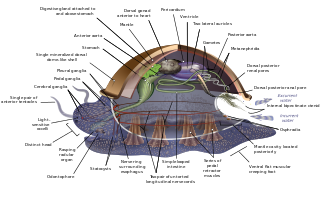
The evolution of the molluscs is the way in which the Mollusca, one of the largest groups of invertebrate animals, evolved. This phylum includes gastropods, bivalves, scaphopods, cephalopods, and several other groups. The fossil record of mollusks is relatively complete, and they are well represented in most fossil-bearing marine strata. Very early organisms which have dubiously been compared to molluscs include Kimberella and Odontogriphus.

Prolecanitoidea is a taxonomic superfamily of ammonoids in the order Prolecanitida. Prolecanitoidea is one of two superfamilies in the order, along with the younger and more complex Medlicottioidea. The Prolecanitoidea were a low-diversity and morphologically conservative group. They lived from the Lower Carboniferous up to the Middle Permian. Their shells are generally smooth and discoidal, with a rounded lower edge, a moderate to large umbilicus, and goniatitic to ceratitic sutures. Suture complexity varies from 10 up to 22 total lobes ; new lobes are added from subdivision of saddles adjacent to the original main umbilical lobe.

Rhynchonelliformea is a major subphylum and clade of brachiopods. It is roughly equivalent to the former class Articulata, which was used previously in brachiopod taxonomy up until the 1990s. These so-called articulated brachiopods have many anatomical differences relative to "inarticulate" brachiopods of the subphyla Linguliformea and Craniformea. Articulates have hard calcium carbonate shells with tongue-and-groove hinge articulations and separate sets of simple opening and closing muscles.
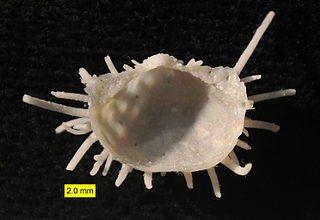
Productida is an extinct order of brachiopods in the extinct class Strophomenata. Members of Productida first appeared during the Silurian. They represented the most abundant group of brachiopods during the Permian period, accounting for 45-70% of all species. The vast majority of species went extinct during the Permian-Triassic extinction event, though a handful survived into the Early Triassic. Many productids are covered in hollow tubular spines, which are characteristic of the group. A number of functions for the spines have been proposed, including as a defensive mechanism against predators.

Kutorginates (Kutorginata) are an extinct class of early rhynchonelliform ("articulate") brachiopods. The class contains only a single order, Kutorginida (kutorginides). Kutorginides were among the earliest rhynchonelliforms, restricted to the lower-middle part of the Cambrian Period.
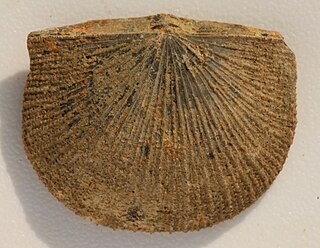
The orthotetides (Orthotetida) are an extinct order of brachiopods in the class Strophomenata. Though not particularly diverse or abundant relative to strophomenides (Strophomenida) or productides (Productida), orthotetides were nevertheless the longest-lasting order of strophomenates, surviving from the Middle Ordovician (“Llanvirn”) up until the Late Permian. Externally, many orthotetides are difficult to distinguish from strophomenides. Most fundamental differences between the two orders are internal: orthotetides have more elaborate cardinal processes and a greater diversity of shell microstructure.
Productidina is a suborder of brachiopods containing the families:
Diaphragmus is an extinct genus of brachiopod belonging to the order Productida and family Linoproductidae. Specimens have been found in Carboniferous beds in North America.
Pugnoides is an extinct genus of brachiopod belonging to the order Rhynchonellida and family Petasmariidae. Specimens have been found in Devonian to Permian beds in North America, Asia, Europe, western Australia, New Zealand,and New Zealand. The genus was particularly widespread in the Visean.
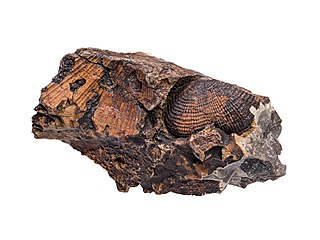
Productidae is an extinct family of brachiopods which lived from the Upper Devonian to Upper Permian periods in marine environments. It is the most diversified family in the suborder Productidina, with some 100 genera.

Echinoconchinae is an extinct subfamily of brachiopods which lived during the Carboniferous and Permian periods in marine habitats. The family had a cosmopolitan distribution.

Echinoconchus is an extinct genus of brachiopods which lived during the Lower Carboniferous period. The genus was abundant and had a cosmopolitan distribution.
Echinaria is an extinct genus of brachiopods which lived during the Upper Carboniferous and Lower Permian periods. Its fossils have been found in Eurasia, North America and northern South America.
Juresaniinae is an extinct subfamily of brachiopods which lived during the Carboniferous and Permian periods in marine habitats.
Pustulinae is an extinct subfamily of medium to large-sized brachiopods which lived during the Early Carboniferous period in marine habitats. It is named after the type genus Pustula.
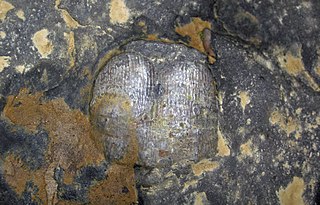
Antiquatonia is an extinct genus of brachiopod belonging to the order Productida and family Productidae. Specimens have been found in Carboniferous beds across many continents, suggesting the genus had a cosmopolitan distribution. Species level taxonomy of Antiquatonia is in need of revision.
Pustula is an extinct genus of brachiopods which lived during the Carboniferous period. It is the type genus of the subfamily Pustulinae. Its fossils have been found in Eurasia, North America and northern Africa.
Pulchratia is an extinct genus of brachiopods which lived in marine habitats during the Upper Carboniferous period. Its fossils have been found in North America.










